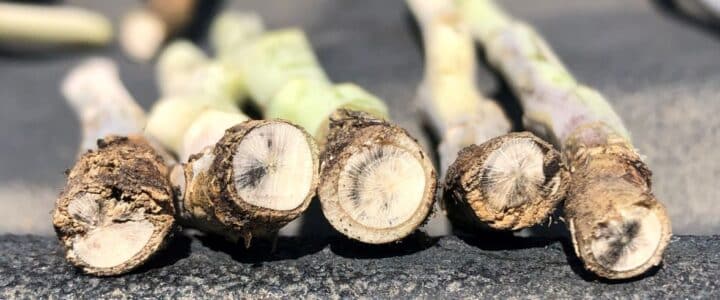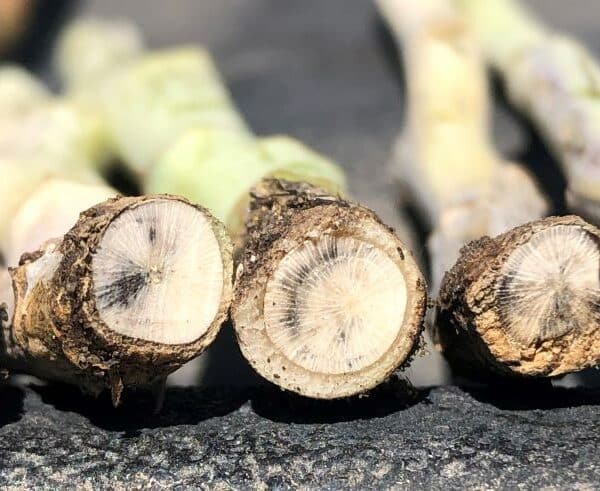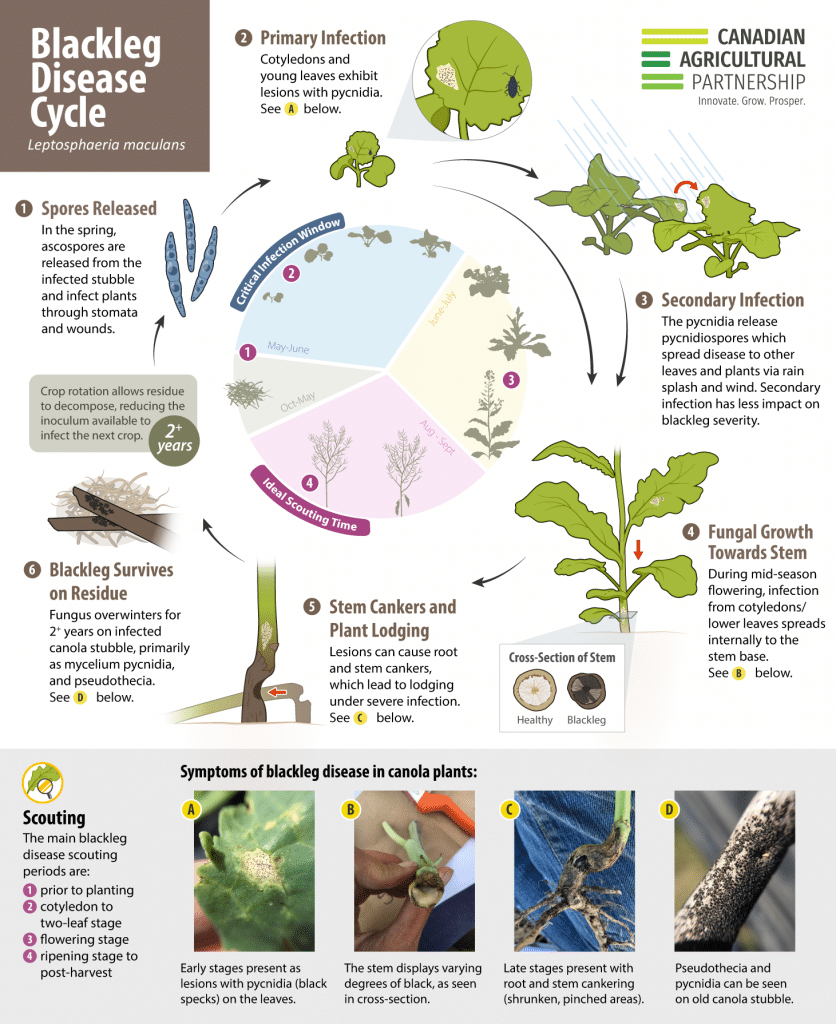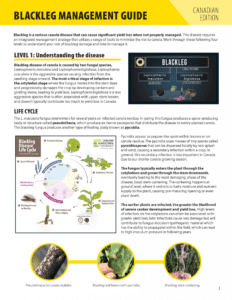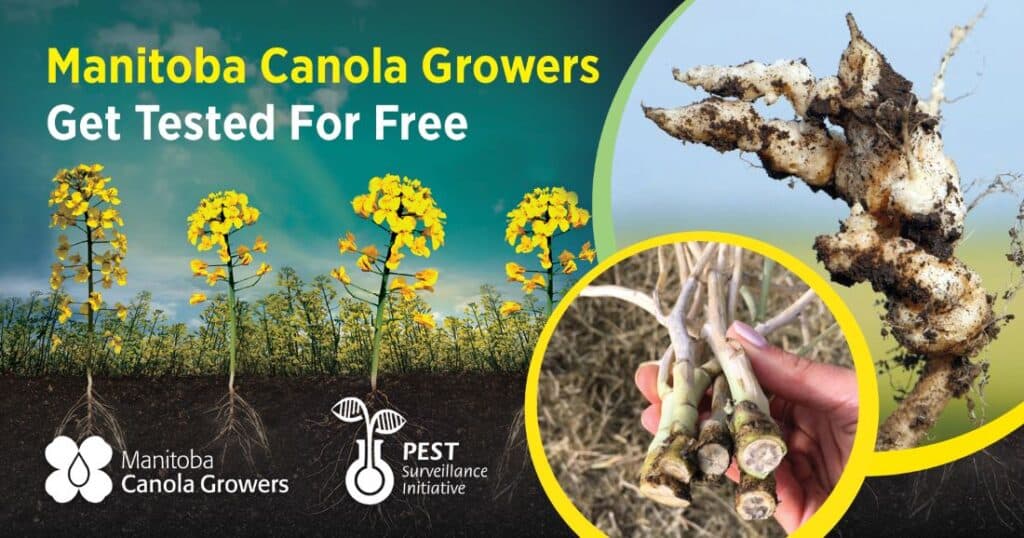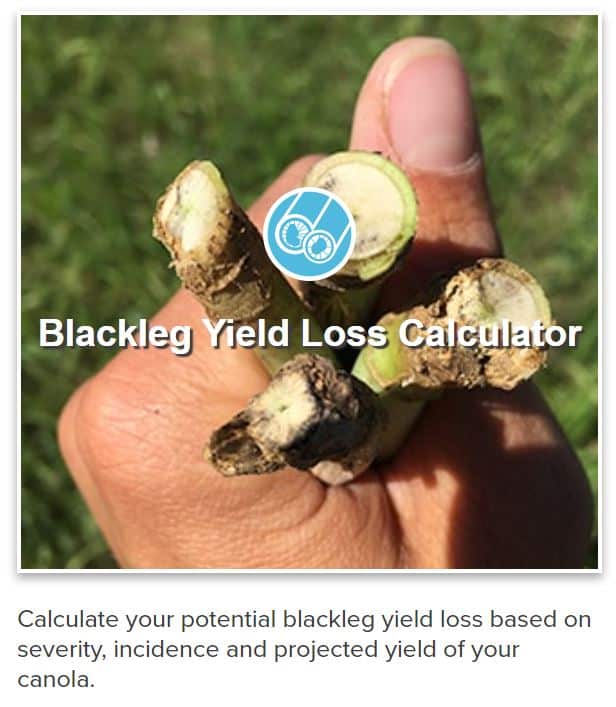Blackleg is a disease in canola that is a potential concern every year and can cause serious yield losses. As stated in the CCC’s Blackleg management guide, blackleg disease of canola is caused two fungal species: Leptosphaeria maculans (an aggressive species causing infection from the seedling stage onward) and Leptosphaeria biglobosa (a less aggressive species that is often associated with upper stem lesions and doesn’t typically contribute too much to yield loss in Canada).
The CCC’s Blackleg management guide uses an integrated management strategy, referencing several helpful tools, to outline the four levels to understanding and minimizing the risk of blackleg damage and how to manage it. The first two levels of this strategy are understanding the disease and determining the blackleg severity of a canola crop (while scouting). The CCC’s blackleg disease cycle graphic can be referenced for both of these priorities.
It explains that after L. maculans overwinters on infected canola residue, the blackleg disease cycle can be considered to begin in the spring with the release of ascospores (and potential infection of canola cotyledons). The cotyledon stage is most critical stage of infection, where the fungus moves into the stem base and progressively damages the crop. However since symptoms are most obvious later in the season, when canola is at ~60% seed colour change, blackleg disease scouting is recommended just prior to swath timing. See the CCC graphic shown for more details.
The last two levels of the integrated management strategy make several references to genetic resistance, which emphasize the importance of it. Level three is learning and implementing best management practices that can reduce blackleg risk level – which includes a recommendation for planting resistant (R) or moderately resistant (MR) cultivars and a recommendation for rotating use of resistance sources in cultivars. The final levels explains the blackleg resistance identification system – including the major gene (seedling) resistance and quantitative (adult plant) resistance.
The importance of genetic resistance in canola cultivars is also represented by the number of blackleg-related research projects which are carried out on various aspects of this topic. Results and recommendations coming out of a few of the more recent studies are summarized below in support of the four levels of effective blackleg management.
Background on blackleg populations in Canada
Peng’s ‘Analysis and monitoring of Leptosphaeria maculans race dynamics in western Canada for effective blackleg resistant management strategies’ research report also acknowledged that cultivar resistance – along with crop rotation – in western Canada were key to the successful management of blackleg during the 1990s and 2000s. However there has been increased prevalence and severity more recently, which is potentially related to pathogen population shifts and tighter crop rotations. In 2012, a large number of fields with resistant (R) or moderately resistant (MR) cultivars were found with severe blackleg, especially in southern Manitoba and parts of Alberta. This breakdown may have been due to changes in pathogen producing virulent races that can overcome the R genes in canola cultivars.
The importance of cultivar resistance was also noted in the Blackleg management guide. It recognized that canola cultivars can have different combinations of blackleg resistance genes, and explained that growing cultivars with the same blackleg resistance genes can lead to changes (natural selection) in the blackleg pathogen’s virulence (ability to cause disease), enabling it to overcome the resistance deployed in the cultivars. Therefore, it recommends using a L. maculans race identification test to determine predominant L. maculans races in a field, which can then be used to match appropriate resistance sources in cultivars, if known. This knowledge can also allow for effective resistance rotations, since similar to herbicide group rotation, rotating blackleg major resistance genes will slow the L. maculans races from becoming resistant towards these genes.
Apply this research on your farm
- Use blackleg race identification tests to learn which populations are in your canola fields, then match them with cultivar resistance sources.
- Continue growing blackleg-resistant cultivars (and note that quantitative resistance is still effective under high-temperature conditions).
- Implement longer crop rotations on fields with high blackleg pressure (to allow more time for blackleg inoculum levels to decline, as old canola stubble decomposes).
- Explore Blackleg.ca and its resources.
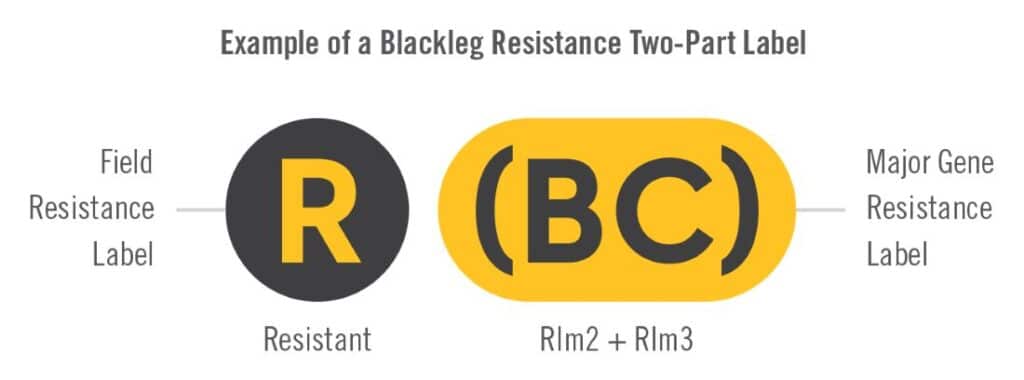
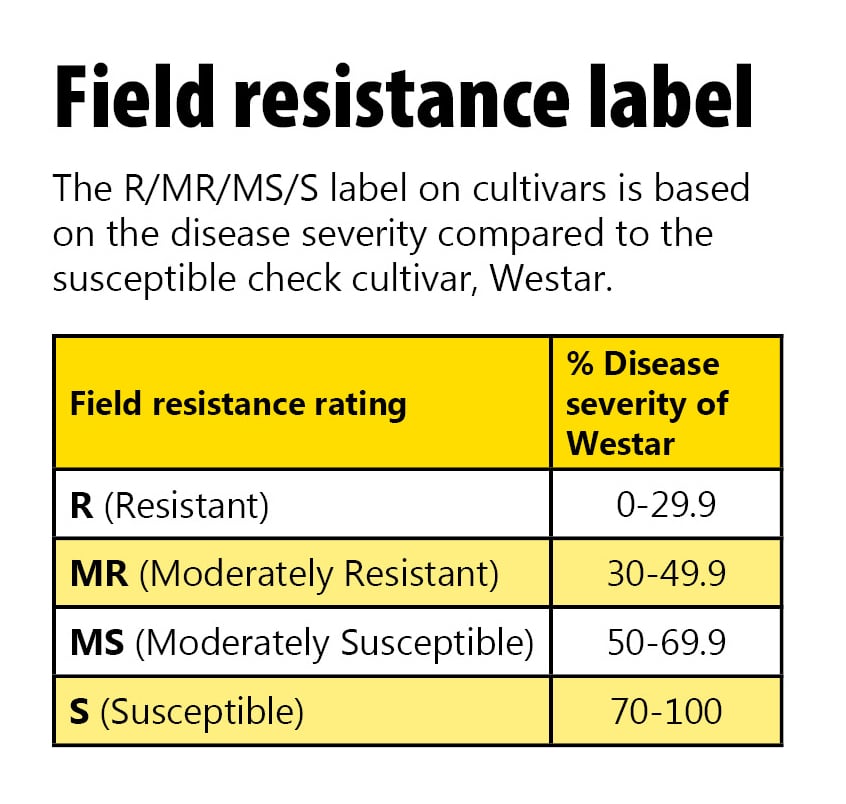
However, Peng’s report points out that in order to deploy R genes effectively, the pathogen race composition (the Avirulence profile or Avr profile) and dynamics needs to be known. Fortunately, blackleg race identification and monitored work was initiated in 2007 using nine “Westar” trap plots, and found that Avrlm1 and AvrLepR2 were generally low in the pathogen population while the other Avr genes were at moderate to high levels. Another study using samples collected from commercial fields in 2010 and 2011 found that populations of AvrLm3 and AvrLm9 had decreased substantially from previously observed levels, and AvrLm7 had increased.
Building on those projects, the ‘Analysis and monitoring of Leptosphaeria maculans race dynamics in western Canada for effective blackleg resistant management strategies’ study aimed to analyze and monitor the Avr profile using Westar trap plots for regional pictures of Avr frequencies in the pathogen population.
Peng’s research team’s efforts culminated in:

- Identifying the prevalence and changes of Avr genes in pathogen populations on the Prairies between 2012 and 2015, where AvrLm2, AvrLm4, AvrLm6,(8) and AvrLm7 were found at high frequencies while AvrLm1 and AvrLm3 were generally low.
- This information is useful to canola breeding companies for deploying effective R genes against the current pathogen population on the Prairies.
- Since only the Rlm1 and/or Rlm3 were found commonly in Canadian cultivars, it is likely that the major-gene resistance to blackleg is currently lacking on the Prairies due to the generally low presence of AvrLm1 and AvrLm3 in the pathogen population.
- Therefore, it is hypothesized that the blackleg resistance in many of the R-rated canola cultivars is quantitative/adult plant resistance, which is race nonspecific.
- It is also expected that Rlm4, Rlm6 or Rlm7 can substantially improve the blackleg resistance in most regions on the Prairies, especially when used with proven background resistance.
- Therefore it would be ideal to identify the prominent Avr types in a specific field, and then use a canola cultivar that is effective against the pathogen population in that specific field.
- Where severe blackleg damage occurs in a field, a longer crop rotation can act as the first line of defense.
Quantitative resistance reduces blackleg impact on canola without major resistance genes and is effective in high temperatures
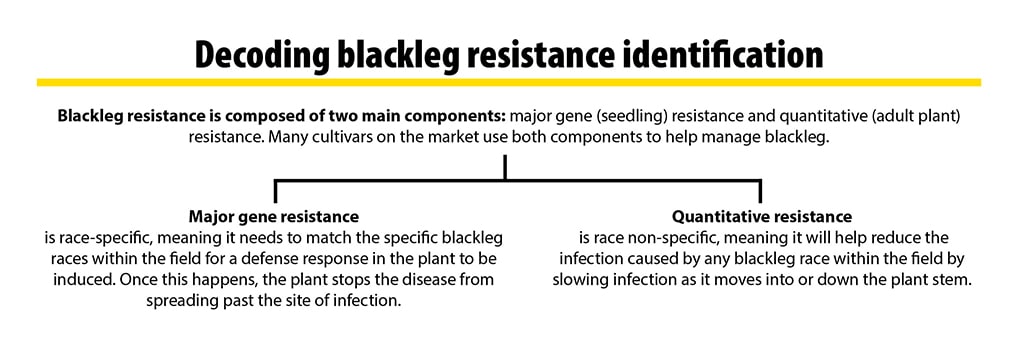
As noted in previous research, most canola cultivars grown in Western Canada carry the specific (major gene) blackleg resistance (R) genes Rlm1 and/or Rlm3. But Peng noted that recent field monitoring data indicated that some of these R genes are no longer effective. Despite this, severe blackleg damage is still uncommon on these resistant cultivars, suggesting additional resistance mechanisms, known as quantitative resistance, may be present.
Quantitative resistance has the potential to provide a more durable, if less complete, protection of canola against blackleg. However, the effectiveness of quantitative resistance may also vary widely in the field, and it has long been suspected that elevated temperatures may negatively affect the expression of quantitative resistance. So the ‘Understanding the mechanisms for race-specific and non-specific resistance for effective use of cultivar resistance against blackleg of canola in Western Canada’ study set out to understand more about quantitative resistance.
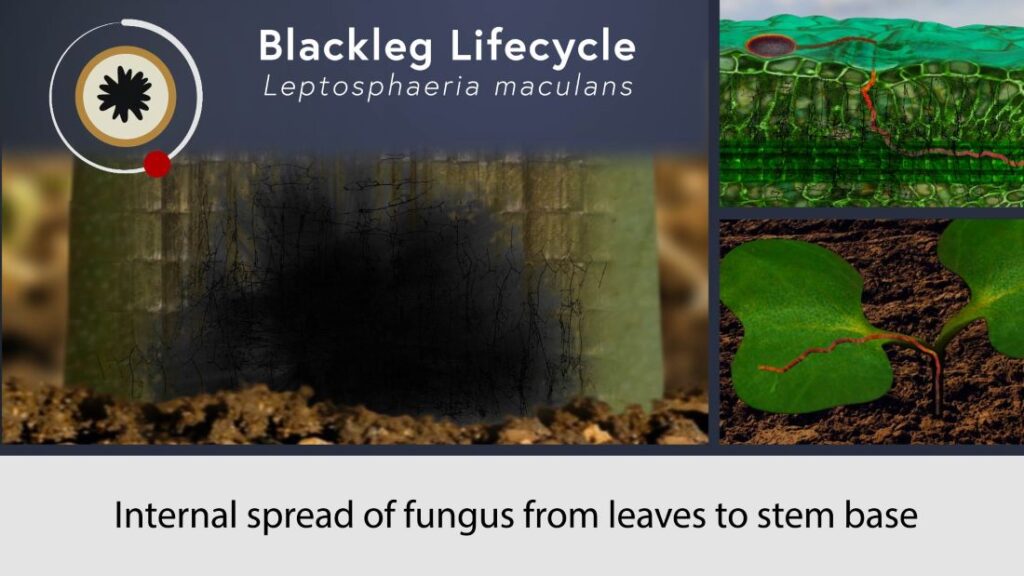
Researchers took three blackleg-resistant canola cultivars carrying Rlm1 and Rlm3 and inoculated them with virulent isolates of Leptosphaeria maculans that should overcome these two major resistance genes. The cultivar Westar was used as a susceptible control.
The key findings from this 2015-2018 study are:
- Characterizing blackleg resistance associated with common canola cultivars used in western Canada.
- Quantitative resistance was determined to be valuable in alleviating blackleg impact on canola without the direct involvement of major resistance (R) genes.
- This is achieved by limiting the spread of fungal hyphae in infected cotyledons further into stems (reduced blackleg incidence) and/or the infection in stem tissues after the pathogen enters it (reduced disease severity).
- Quantitative resistance was determined to be valuable in alleviating blackleg impact on canola without the direct involvement of major resistance (R) genes.
- Understanding the molecular mechanisms of the resistance gene Rlm1 based on RNA sequencing.
- These resistance mechanisms are different from those of single R genes showed by Rlm1 that induce localized reactions in response to the infection by L. maculans (Lm) carrying the avirulence (Avr) gene AvrLm1, which halts the infection immediately by upregulation of many genes involved in the jasmonic acid and salicylic acid pathways. This is the first time that molecular mechanism with a specific blackleg resistance gene (Rlm1) is identified.
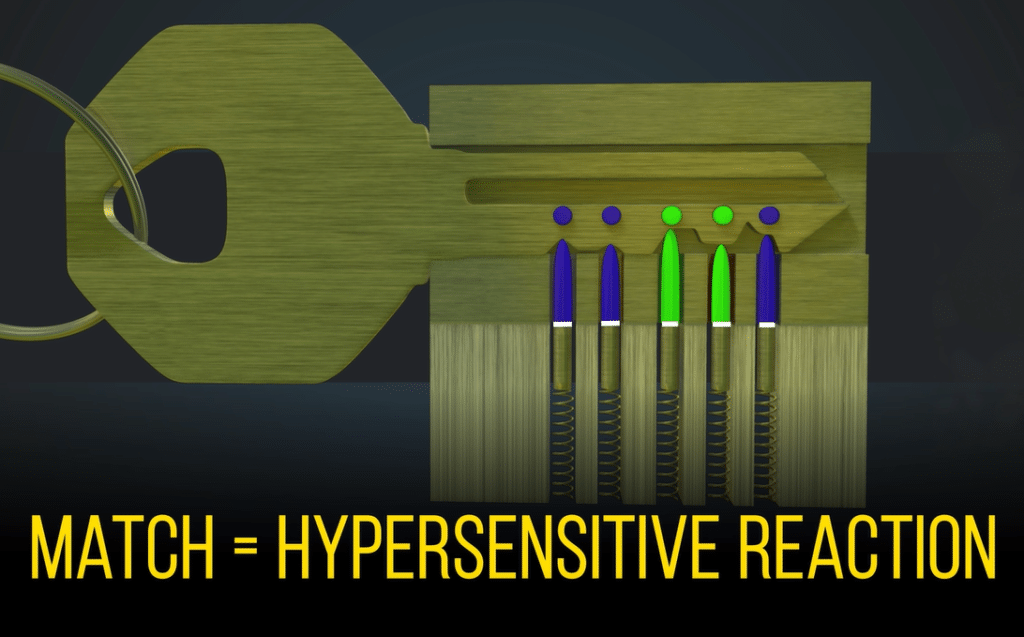
- Molecular mechanisms of quantitative resistance in cotyledons of 74-49 BL revealed by RNA sequencing.
- Using the canola cultivar 74-44 BL, the mechanism underlying quantitative resistance against blackleg was explored and different genes (as opposed to those involved in Rlm1) were found to express differentially, with the highest gene expression associated with those involved in programmed cell death, reactive oxygen species generation and intracellular endomembrane transport. Once confirmed, this will be first report on the molecular mechanisms of quantitative resistance against plant diseases.
- The study on the impact of elevated temperature on quantitative resistance expression indicated:
- Common canola cultivars with a quantitative resistance background are effective under high-temperature conditions during heat waves, confirming that quantitative resistance traits can be stable under a wide range of field temperatures.
Aim to rotate major genes, while still using quantitative resistance
As previously noted, despite all canola cultivars registered in Canada having good levels of resistance to blackleg disease, Leptosphaeria maculans can rapidly overcome resistance. Repeated use of the same canola cultivars (which isn’t recommended) can speeds the fungus’ adaptation to resistance genes. However, simply changing cultivars may be ineffective because producers have no way of knowing which resistance genes they are deploying.
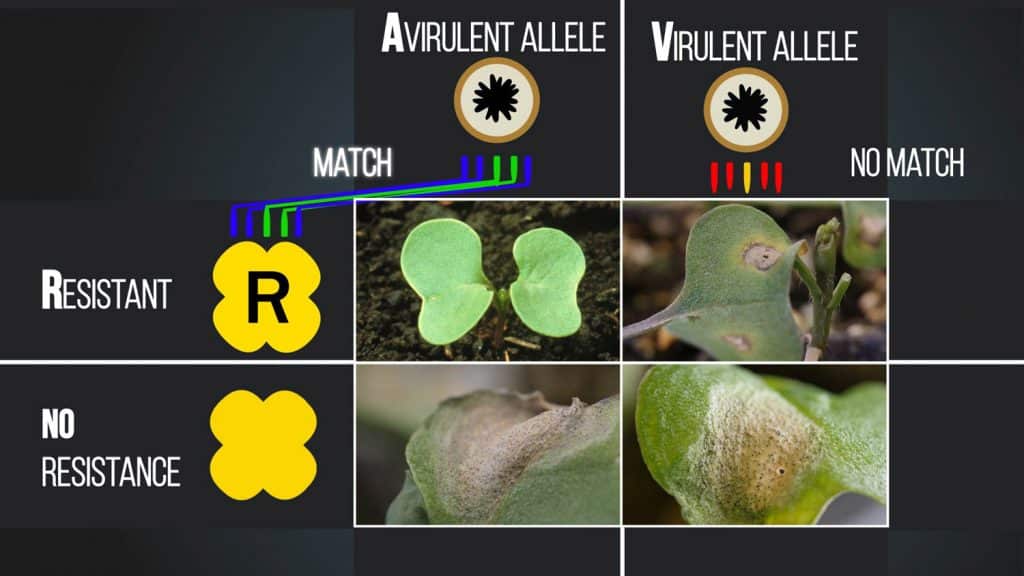
The goal of the Development of canola cultivar blackleg resistance groups: feasibility project was to determine if canola cultivars could be grouped based on their susceptibility to different L. maculans populations. The approach that was used involved inducing spore formation on the crop residues and pooling spores from many fungal fruiting bodies to represent the combinations of L. maculans strains present in field.
Result from this study implied resistance grouping may not be feasible. Therefore, labelling of individual genes, as is starting to be implemented by the canola industry, will allow growers to rotate major genes, while still taking advantage of quantitative resistance. Read more on the research summary page.
Optimize blackleg management on your farm
As noted in the CCC’s Blackleg management guide and supported by the research above, these best management practices can reduce the risk of blackleg:
- Extending canola rotations (to greater than a two-year break from canola) will allow more time for blackleg inoculum levels to decline, as old canola stubble decomposes.
- Explore Blackleg.ca and watch the Blackleg disease and resistance management video for better understand the blackleg disease and management options.
- Look for internal stem blackening at ground level when scouting during swathing or straight cutting, and for pseudothecia on previous year’s canola residue prior to seeding.
- Watch this ~1-minute Canola Watch: Blackleg Scouting video prior to scouting to maximize effectiveness.
- Check out Canola Watch’s Agronomy: Steps to make an accurate diagnosis fundamentals article.
- Plant either “Resistant” (R) or “Moderately Resistant” (MR) cultivars as resistant cultivars outperform susceptible or bin run seed.
- Use the Blackleg yield loss calculator to measure performance and determine potential blackleg yield loss based on severity, incidence and projected canola yield.
- Learn more about blackleg resistance with the CCC’s Understanding Blackleg Resistance guide.
- Use a L. maculans race identification test to determine predominant L. maculans races in the field to help match appropriate resistance sources.
- Growers are encouraged to survey their fields and take advantage of available disease testing programs:
- Private labs in Alberta are available for testing.
- Free blackleg (and clubroot) testing is available through SaskCanola and the Saskatchewan Ministry of Agriculture.
- Free blackleg, clubroot and verticillium stripe testing is available through Manitoba Canola Growers’ Pest Surveillance Initiative Lab.
- Growers are encouraged to survey their fields and take advantage of available disease testing programs:
- Consider adding a fungicide seed treatment to canola cultivars, as seed treatment fungicide protects plants from blackleg when they are most susceptible.
- An early season foliar fungicide application can help to prevent yield losses if applied during the cotyledon to two-leaf stage.
- Later foliar applications can help to reduce the inoculum in the field.
Canola growers can also sign up to be part of provincial disease surveys.
Read more about blackleg in Grower-submitted canola samples support collective efforts to manage blackleg blog.
Further blackleg research
Check out the summaries for these blackleg-related research projects:
- Mitigating the risk of blackleg disease of canola using fungicide strategies
- Defining populations of the L. maculans pathogen in test sites used for canola blackleg resistance trials
- Introgression of the highly effective Brassica rapa blackleg resistance gene Rlm11 into spring-type Brassica napus
- Introgression of disease resistance from Brassica nigra into canola using new-type Brassica napus
- Durable blackleg resistance stewardship through knowledge of blackleg pathogen population, resistance genes and crop sequence towards the development of a cultivar rotation program in the Prairie Provinces
- Development of a blackleg yield loss model and assessment of fungicide resistance in Western Canadian populations of Leptosphaeria maculans
All other blackleg-related research projects are available here on the Canola Research Hub.
Published August 18, 2022


